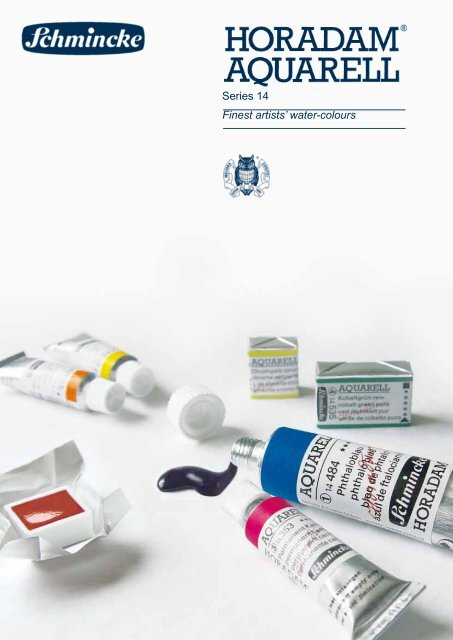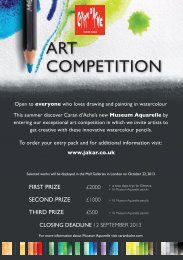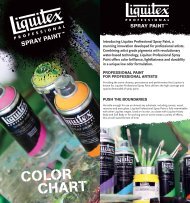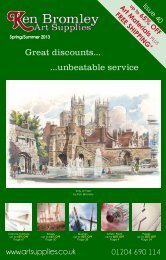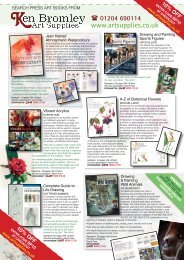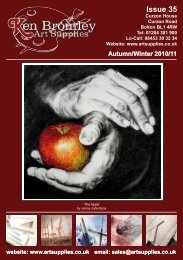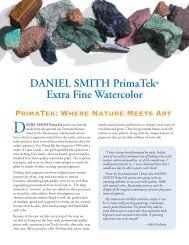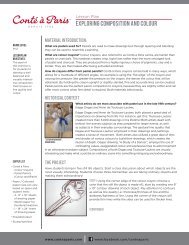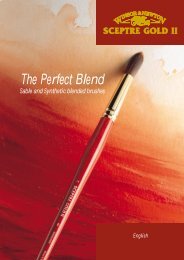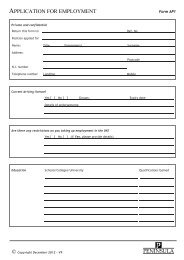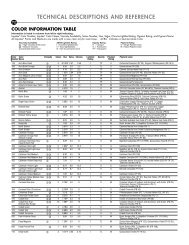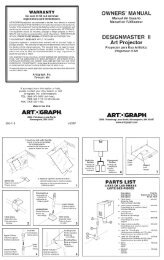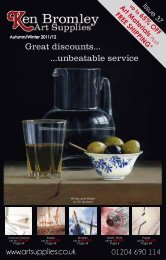Series 14 Finest artists' water-colours
Series 14 Finest artists' water-colours
Series 14 Finest artists' water-colours
Create successful ePaper yourself
Turn your PDF publications into a flip-book with our unique Google optimized e-Paper software.
<strong>Series</strong> <strong>14</strong><strong>Finest</strong> artists’ <strong>water</strong>-<strong>colours</strong>
HORADAM ® AQUARELL – finest artists’ <strong>water</strong>-<strong>colours</strong>• 110 Colours in large and small pans,in 5 ml- and 15 ml-tubes• Each colour has its own individually optimizedformula• Pans poured 4 times in liquid state• Highest light fastness despite of extra strictresistance validation• Fully reusable paint when dried on a palette• High control of paint flow,even on soft <strong>water</strong>-colour papers• High quality standard “Made in Germany”PhilosophyThe Schmincke founders motto“MELIORA COGITO”“I strive for the best” remains as it was in 1881, the year of the foundation. In1893 Josef Horadam, one of the founders of H. Schmincke & Co., had set standardswith theHORADAM ® finest artists <strong>water</strong><strong>colours</strong>for which he receiveda European patent. The premium quality of HORADAM ® AQUARELL <strong>colours</strong> hasbeen already recognized in former times by famous artists like Nolde, Kokoschkaand others, to be the very best.Until today it is our goal to offer the very best artists‘ <strong>water</strong><strong>colours</strong>worldwide: premium quality made in Germany.Josef Horadam, 1844–1917The HORADAM ® AQUARELL assortment110 <strong>colours</strong> represent the HORADAM ® AQUARELL range.65 <strong>colours</strong> are formulated with one pigment only, the ideal concept for professional paintingand for colour mixing. Many of the new artists’ pigments have been researched andtested to comply with the highest quality standard regarding stability, fineness, resolubilityand lightfastness. To achieve the outstanding characteristics, like reusable paint whendried on a palette and the high control of paint flow even on soft <strong>water</strong>-colour papers weonly use thebest raw materials. In its coloristic appearance the total assortment is particularly harmonious,balanced and complete.No compromise in quality –Highest standards of artists‘ pigments allowhighest light fastnessThe lightfastness is an objective characteristic, which depends not only on the pigmentitself, but also on the complete formula. Therefore Schmincke does not only use thelightfastness given by the pigment itself but makes tests of the complete formula of eachshade in the fast Xenontest and / or on the roof of the Schmincke factory for a prolongedperiod.To be able to test properly and classify <strong>colours</strong> strictly according to our 5-star-systemattached to the “woolscale”, such intensive testing is absolutely vital.It is self-understood that no <strong>water</strong>-colour painting should be exposed to direct sunlightfor a longer time due to the usually fine and thin and thereby lightsensitive colour application.2
HORADAM ® AQUARELL – finest artists’ <strong>water</strong>-<strong>colours</strong>Especially selected Gum ArabicOne main ingredient of the <strong>water</strong>-colour binding medium is Kordofan Gum Arabic from thesouthern Sahara region. Like most natural products this traditional <strong>water</strong>-colour binding mediumdiffers from year to year. Therefore Schmincke is testing Gum Arabic every time beforepurchase and selects only the best crop of the respective year. This adds small but significantquality advantages. Other formula ingredients are selected equally carefully and of course areintegrated in each formula in an individual optimised way to obtain a harmonious assortment,that can be easily picked up by the brush.Advertisement from 1893Oxgall – more than a wetting agentAn important criterion for the highest quality is the control of a <strong>water</strong>-colour application withoutundissolved pigment and undesired cloud formations. The perfect flow of the HORA-DAM ® AQUARELL <strong>water</strong>-colour is guaranteed by the optimal amount of oxgall. It is the decisionof the artist – not of the colour – where the application should flow moist in moist or if the <strong>colours</strong>hould stay dry on the paper.Pouring <strong>water</strong>-<strong>colours</strong> in liquid state, or how thereal quality is bornAnother traditional quality criterion is the re-usability of theHORADAM ® AQUARELL <strong>water</strong>-<strong>colours</strong> while using the same formulation for tubes andpans. Both properties, the re-usability and the control of the paint flow can only be achievedby pouring <strong>water</strong>-<strong>colours</strong> into pans in a liquid state, which is really unique. This productionprocess means, to fill the pans 4 times, allowing the colour to dry and settlebetween each filling.The first step is to fill the pan with the colour and let it dry for some weeks in a drying chamberto a certain degree of residual moisture. The second, third and forth step follows the sameprocedure. That means that each single pan is ready for sale only after 3 – 5 months.Flüssiggießverfahren / Pouring <strong>water</strong>-<strong>colours</strong> in liquid state3
HORADAM ® AQUARELL – symbols and testingTo inform you in the best possible way about Schmincke HORADAM ® artists’ <strong>water</strong>-<strong>colours</strong>we use individual descriptions and also different symbols: ( H ).Some remarks in this framework:Color Index and Pigment namesThe Color Index system is an international standard to denominate dyes and pigments. Inthe C.I. a combination of letters and numbers indicate the colour category (C.I.-Name) i.e.PO 20 means Pigment Orange 20.The groups of Color Index names are:PW= Pigment white PB = Pigment bluePY = Pigment yellow PG = Pigment greenPO = Pigment orange PBr = Pigment brownPR = Pigment red PBk = Pigment blackPV = Pigment violetOpacity and glazing propertiesThe opacity of a pigmented colour is not only depending on the thickness of the colourapplication but also on the distribution and size of the pigments as well as the height of therefractive index of the applied colour.All <strong>colours</strong> have been submitted to the same testing method: standardized application onblack and white striped saturated base as well as on white 200 g <strong>water</strong>-colour paper. Thisallows a classification with the following 4 symbols:transparent semi-opaquesemi-transparent opaqueLightfastnessThis describes the durability of a colour in daylight. The lightfastness therefore is not onlyreferring to the pigment, but always to the total system – pigment, binding medium, additives.A number of influencing factors play a role too, like intensity of sunlight, temperature,moisture, oxygen or gas content of the air. The importance and combination of the variousinfluencing factors vary depending on daytime and season as well as on geographic factors.In connection with the textile industry we use as an objective scale the so called blue woolscale. This testing method consists of 8 wool stripes tinted with different lightfast dyes. Thelightfastness is expressed in numbers. 1 means very low, 8 is the highest lightfastness accordingto the measurable changes of the 8 wool stripes in a given time. We translate those findingsinto our 5-star system. This allows a more precise differentiation especially in the morelightfast categories than with the usual 3 or 4 steps used by other producers.Blue wool scale Stars8 H H H H H extremely lightfast7 H H H H good lightfastness5 + 6 H H H lightfast4 H H limited lightfastness3 H less lightfast1 + 2 – not lightfastLightfast colour systems require very long testing periods under naturallight. For the testing of pigmented colour systems we therefore also use intensive exposureinstruments to speed up this process. This does not only allow faster classification,but also permits to obtain reproducible results independent of location, climate and time.Such testing instruments contain Xenon light, which are adapted to daylight by using filters.Longterm exposure on the roof represents additional testing.Staining and Non-StainingWater-<strong>colours</strong> applied to paper behave differently in respect to their adhesive power to thepaper. Some <strong>colours</strong> may be washed off with a moist brush or cloth, others stick (“stain”)more or less strongly to paper. To test the grade of staining identified with our 3 symbolsbelow we have applied <strong>water</strong>-colour to 160 g paper and tried to rub it off after 24 hours ofdrying with a dry cloth after washing it with a wet brush.The result is classified in 3 categories:non-stainingsemi-stainingstaining4
HHHHH extremely lightfast transparentHHHH good lightfastness semi-transparentHHH lightfast semi-opaqueHH limited lightfast opaqueH1lless lightfastPrice groupMaster assortmentnon-stainingsemi-stainingstainingPigment(e)Colour No. Name Pigment(s) C.I.-No. Description101lTitaniumopaquewhiteTitanium dioxide PW 6 Brilliant, lightfast white with highest opacity and highest lighteningpower in mixtures. Rutil pigments are acid- and alkali-resistent.1HHHHH ■102lPermanentChinese whiteZinc oxide PW 4 Cold, pure, lightfast traditional zinc white with good white lighteningpower; slightly cold bluish nuance. Reflects also invisible UV-rays bytransforming them into visible rays. Due to transparency the best mixingwhite.1HHHHH782lNeutral tintQuinacridonemagentaIndanthrone blueLamp blackPR 122PB 60PBk 7Traditional violet-grey. Mixture of red violet, blue and black.Recommended for first layers and deepening of green tones.1HHH783 Schminckepayne’s greyRed iron oxideUltramarine blueLamp blackPR 101PB 29PBk 7Traditional Schmincke neutral grey. Mixture of red, blue and black.Slightly cooler than neutral tint.1HHHH787lPayne’s greybluishLamp blackPhthalocyaninebluePhthalocyaninebluePBk 6 Internationally requested bluish variation of Schmincke Payne’sPB 15:6 grey.PB 15:21HHHH785 Neutral greyDiketo-Pyrrolo-Pyrrol PR 255Indanthrone blue PB 60Benzimidazolon PO 62Neutral grey tone from complementary <strong>colours</strong> without black content.Remains colour-neutral even after mixing with white.3HHHH786 Charcoal greyLamp black PBk 7 Brownish greyblack, pigmented with lamp black. Residues of incompletecombustion of organic substances like gas or oil. Consisting ofpure carbon.1HHHH■781 Lamp blackLamp black PBk 6 Greyish black. Residues of incomplete combustion of organic substanceslike gas or oil. Consisting of pure carbon. Recommended forfirst layers.1HHHH■780lIvory blackCarbonized bonesof animalsPBk 9Very deep black. Formerly made from carbonized ivory, nowadays producedby dry destillation of degreased bones. Small quantities of calciumphosphateadd slightly grey-bluish tone. Often used for dark tones andcolour turbidity.1HHHHH5
894lSilverIriodin rutil silverNo bronze, but coated mica with metal oxide (Iriodin).2893lHHHHHGoldGoldIriodin goldpearlYellow gold tone. No bronze, but coated mica with metal oxide(Iriodin).2HHHH930 Brilliant purple TriarylcarboniumPR 81:2 Specially pure and brilliant, cannot be mixed. Equivalent to purplered of the printcolour-scale according to DIN 16508 and DIN 16509.Without evaluation of lightfastness.2940 Brilliantred violetTriarylcarbonium PV 1 Specially pure and brilliant, cannot be mixed. Recommended forgraphic and textile design. Without evaluation of lightfastness.2910 Brilliantblue violetTriarylcarbonium PV 3 Specially pure and brilliant, cannot be mixed. Recommended forgraphic and textile design. Without evaluation of lightfastness.2206 Titanium yellow Rutil-nickel-tintitaniumPY 53Semi-opaque light yellow. Acid- and alkali-resistant. Cool yellow forsoft, thin colour layers.3215lHHHHLemon yellowMonoazoyellow PY 3 Greenish yellow. Heavy metal-free alternative to cadmiumyellow lemon. Good painting and mixing properties. Mixed withphthalogreen results in brilliant tones. Basic yellow for individualmixtures.1 HHH211 Chrome yellowlemon, no leadBenzimidazolone PY 175 Highly transparent lemon yellow tone. Heavy metal-free alternativeto the original toxic chromium yellow lemon, which is not usedanymore.2HHH223 Cadmiumyellow lemonCadmium-zincsulphidePY 35Traditional tone. Cool lemon-cadmium-pigment. Alkali-resistant.Recommended for mixtures of yellow-greenish and green tones.3HHHH207 VanadiumyellowBismutvanadat PY 184 Highly opaque, slightly greenish, cool yellow with modern, nontoxic,pure, durable and colour-intensive pigment. Non-pollutingalternative to cadmium yellow lemon. Creates brilliant mixtures.4HHHH■224lCadmiumyellow lightCadmium-zincsulphidePY 35Strong, brilliant yellow with opacifying character. In the colourtheoryoften used as basic yellow (Y).3HHHH208 AureolinmodernBenzimidazolone PY 151 Pure yellow. Non-polluting alternative to aureolin cobalt yellowbased on a modern, organic pigment.3HHHH6
216 Pure yellowBenzimidazolone PY 154 Brilliant yellow with modern, organic pigment. Heavy metal-free alternativeto cadmium yellow. In thick layers semi-opaque, in thin layerstransparent. Good lightfastness and intermiscibility with other tones.2209lHHHHTranslucentyellowAzo-nickel complex PY 150 Slightly transparent pure yellow or lemon yellow tone, when appliedin thin layers. In thick layers tendency to ochre.2HHHH210 Gamboge gummodernNickel complexAnthrapyrimidinPY 150PY 153PY 108Yellow tone, similar to the former natural, less lightfast and toxicgamboge gum, but now non-toxic, non-polluting with good lightfastness.4HHHH212 Chrome yellowlight, no leadMetal complexDisazopigmentPY 153PY 155Highly transparent light yellow tone. Mixture of two modern,organic pigments. Non-polluting alternative to the original toxicchromium yellow.2HHH225 Cadmiumyellow middleCadmium-zincsulphidePY 35Highly brilliant, strong yellow tone with opacifying character.3HHHH220lIndian yellowIsoindolinoneBenzimidazolonePY 110PY 154Modern replacement of former animal metabolism product fromIndia, which was prohibited long ago. Classic, very transparent,mix of two pigments.2HHHH226 Cadmiumyellow deepCadmiumzinc-sulphideCadmiumsulphoselenidePY 35PO 20Brilliant cadmium yellow tone with opacifying character.3HHHH■213lChrome yellowdeep, no leadMonoazo yellow PY 65 Reddish yellow. Non-polluting alternative to the original used toxicchromium yellow deep. Tendency to orange.2HHH227 Cadmiumorange lightCadmiumsulphoselenidePO 20Strong and brilliant. Good mixing property.3HHHH2<strong>14</strong>lChrome orange,no leadBenzimidazolone PO 62 Non-polluting alternative to the original toxic chromium orange byusing a lightfast, non-toxic, organic pigment.2HHHH228 Cadmiumorange deepCadmiumsulphoselenidePO 20Brilliant, strong orange tone. Opacifying character. Good resultsmixed with other tones.3HHHH■218lTranslucentorangeDiketo-Pyrrolo-Pyrrol PO 71Brilliant orange-red. New developed organic lightfast pigment. Mixedwith phthalogreen soft, neutral grey tones are achieved. The intensivereddish character is ideal for mixtures of very light red tones.2HHH7
361 Permanent redDisazo condensationBenzimidazolonePR 242PO 62Cadmium-free alternative to cadmium red.3HHHH348 Cadmium redorangeCadmiumsulphoselenidePO 20Brilliant tone with opacifying character. To be used as lightest red.3HHHH■365 VermilionDiketo-Pyrrolo-Pyrrol PR 255Metal-free alternative to the traditional vermilion.New developed organic pigment with good lightfastnessand opacifying character.3HHHH■360 Permanent redorangeBenzimidazoloneDisazo condensationPO 62PR 242Cadmium-free alternative to cadmium red orange, tone 348, withlightfast organic pigments.3HHHH349lCadmium redlightCadmiumsulphoselenidePR 108Warm, brilliant red tone.3HHHH■347 Cadmium redmiddleCadmiumsulphoselenidePR 108Expanding range of cadmium red tones. Medium red tone withopacifying character.3HHHH■363lScarlet redDiketo-Pyrrolo-Pyrrol PR 254Scarlet used to be a popular dyestuff (crimson or Cochenille).Nowadays an organic pigmented colour with good lightfastnessand opacifying character.3366lHHHHDeep redPerylen PR 179 Cadmium-free alternative to cadmium red deep, tone 350. Lightfast,organic pigment with perfect solvent-stability and high chemicalresistance. High tinting strength.3HHHH350 Cadmium reddeepCadmiumsulphoselenidePR 108Deep red with slight brownish tendency. Opacifying character.3HHHH■345 Dark redNaphtol AS PR 170 Strong, bluish red.2 HH357 AlizarincrimsonAnthrachinone, AIPR 83:1 Cool, saturated deep red, good transparency. Originally an aluminapigment lake of alizarine, the main dyestuff of the former importantmadder plant. Synthetic production of alizarin since 1870.1H358 Madder lakedeepAnthrachinone, AIAnthrachinonePR 83:1PR 177The lightfastness of the traditional alizarin-tone has been improvedby an anthrachinone pigment. The tone is now deeper.2HH8
354lMadder reddarkQuinacridonePerylenPV 19PR 179Cool, saturated deep red with good transparency. Alternative tomadder lake deep, tone 358, with better lightfastness.3HHHH356 Rose madderAnthrachinone, AIBONS, MnPR 83:1 Traditional colour. Soft pink tone, mixed from two pigments.PR 48:4 The manganesian lake pigment creates bluish red tones.Light- and weather resistance of full tones are relatively good.1HH351 Ruby redQuinacridone red PV 19 Transparent, red-bluish tone. Modern, lightfast, organic pigment.Different colour layers have strong influence on the characterfrom red to deep red.3HHHH353lPermanentcarmineQuinacridone red PV 19 Originally obtained from real Cochenille-louses. Modern pigmentallows today lightfast alternative.3HHHH352lMagentaQuinacridone violet PV 42 Basic colour magenta (M) in colour-theory.3HHH367 Purple Magenta QuinacridonemagentaPR 122Original dyestuff replaced by organic quinacridone pigment. Bluishalternative to basic colour 352, magenta.3HHH368 QuinacridonevioletQuinacridone violet PV 19 Red-violet tone produced from one organic pigment.2HHH474l3ManganesevioletHHHHManganeseammoniumphosphatePV 16Lightfast, soft, brilliant red violet tone. Manganeseammoniumphosphate is similar extracted like in the 18th century frommanganese dioxide minerals and phosphoric acid in connectionwith ammonia. In 1900 firstly used by the artists <strong>colours</strong>manufacturers.476 MauveDioxazine PV 23 Traditional colour with carbozole-violet pigment. Universal use.Bluish violet, cannot be mixed from other pigments.2HH495lUltramarinevioletUltramarine violetUltramarine bluePV 15PB 29Blue violet tone, cannot be achieved by any other colour.Good lightfastness like all other ultramarine pigments, little tintingstrength, coarse-grained.2HHHH482lDelft blueIndanthrone blue PB 60 Strong blue. High tinting strength. Modern, lightfast organicpigment. Warm, deep blue tone with high depth effect.3HHHH■498 Dark blue indigoIndanthrone blue PB 60 Lightfast, slightly w ment.3HHH9
485lIndigoPhthalocyanine blueIndigo syntheticPB 15:1PB 66Originally traditional plant dyestuff from India. For lightfastnessreasons replaced by synthetic, organic pigments. Perfect forshading and deepening of coloured tones.2HH■488 Cobalt bluedeepCobalt-zincsiliciumoxideSpinel (Co, Al)PB 74PB 28Very lightfast, deep blue, more reddish than tone 487, cobalt bluelight. Coarse-grained. Tone and chemistry very similar to smaltsblue of the late middle age. Often used to paint sky and horizon.4HHHHH494lUltramarinefinestUltramarine blue PB 29 Ultramarine has been extracted in the middle age from the semipreciousstone Lapislazuli. Artificial production of equal standardsince 1830. Also used as basic colour for violet tones.2HHHH486 Cobalt bluetoneZinc oxideUltramarine bluePW 4 PB Metalfree alternative to cobalt blue. Semi-transparent tone due to29 zinc white content.1HHHH487 Cobalt blue lightCobalt-aluminium-oxidePB 28Clear blue. Pure valuable cobalt pigment discovered end of the 18thcentury. Best suited for landscape and blue sky painting.4HHHHH496 UltramarinebluePhthalocyanine blueUltramarine bluePB 15PB 29Strong, saturated blue. Two pigment mix. Slightly dimmer than tone494, ultramarine finest.2HHHH480lMountain blueZinc sulphide/BariumsulfateUltramarine bluePhthalocyanine greenPW 5PB 29PG 7Traditional tone. The pigments mixed with white result in a lightfastlight blue. Ideal for neutral, soft blue tones.1HHHH478 Helio bluereddishPhthalocyanine bluePhthalocyanine bluePB 15:6 Specially modified phthalocyanine pigment. Thick colour layersPB 15:2 result in an untypical warm phthalo blue tone.2HHHH492lPrussian blueIron cyan blue PB 27 Traditional tone with high lightfastness.1HHHH491 Paris bluePhthalocyanine bluePhthalocyanine blueIron cyan bluePB 15PB 15:1PB 27Traditional deep blue. High tinting strength and good lightfastness.Tone is achieved by mixture of 3 pigments. Slightly more greenishthan tone 492, Prussian blue.2HHHH484lPhthalo bluePhthalocyanine bluePB 15:1 Traditional deep greenish blue tone. High tinting strength.Mixed with yellow very brilliant green tones are achieved.1HHHH479 Helio ceruleanPhthalocyanine bluePB 15:3 Cerulean blue based on phthalocyanine. Pigment specially treatedto be used for <strong>water</strong>-<strong>colours</strong>. Basic blue tone for mixtures. Close tocyan tone (C).1HHHH10
481lCeruleanblue toneZinc oxidePhthalocyanine bluePW 4 Cobalt-free cerulean blue. The zinc oxide preserves the characterPB 15:3 of the colour. Similar to basic colour (C) of colour-theory. Similar tohelio cerulean.1HHHH499 Cobalt cerulean Cobalt pigmentcombinationPB 36Cobalt blue tone with greenish tendency. Cobalt cerulean pigmentsare known since the beginning of the 19th century. Fastnessproperties same as cobalt blue.4HHHHH475lHelio turquoisePhthalocyanine blue PB 16 Greenish blue. Metal-free phthalocyanine blue pigment.1HHH509lCobalt turquoiseCobalt-lithium-titanium-zinc oxidePG 50Very lightfast turquoise, opacifying character. Very brilliant.4HHHHH510 Cobalt greenturquoiseCobalt pigmentcombinationPB 36More greenish than tone 499, cobalt cerulean with equally highlightfastness.4HHHHH ■528lPrussian greenPhthalocyanine green PG 7Indanthrone blue PB 60Originally mixed colour from Prussian blue and not lightfast yellowlake.Nowadays mixture of two lightfast pigments. Well suited for bluishshadings in landscape painting.2HHHH519lPhthalo greenPhthalocyanine greenPG 7Extremely brilliant transparent green. Alternative to Chromiumoxide green brilliant, shade 511. Well suited for mixtures with yellowand red tones. Recommended for landscape painting.1HHHH511 Chromiumoxidegreen brilliant2HHHH5<strong>14</strong> Helio greenHydrat chromiumoxidePhthalocyanine greenPG 18PG 7BromidePG 36Phthalocyanine greenHighly transparent, cool, very lightfast standard tone. In the middleof the 19th century this tone replaced the former toxic copper<strong>colours</strong>. Well suited for mixture of brilliant green tones with yellowparts.Transparent, brilliant green. Tone achieved by substitution of chlorinewith bromide in the pigment molecule. Supplement to the organicpigmented green series. Warmer than tone 519, phthalo green.2HHHH530 Sap greenMetal complex PY 153Phthalocyanine greenPG 7Highly transparent green. Very famous in the 18th and 19th century,made from berry juice. At that time extremely sensitive to light. Todayalternative organic pigment mixture.2HHH526 PermanentgreenDisazopigment PY 155Phthalocyanine greenPG 7Brilliant yellow-green tone. Mixed colour of two lightfast pigments.Slightly more neutral than 524, may green.2HHHH524lMay greenBenzimidazolone PY 151Phthalocyanine greenPG 7Traditional brilliant yellow-green tone. Contains 2 transparent,lightfast pigments. Recommended for landscape painting.2HHHH11
521 Hooker’s greenPhthalocyaninePhthalocyanine greenHydrated iron oxidePB 15:3PG 7PY 42Since mid of the 18th century a mixture of gamboge gum, Prussianblue and partly indigo was used for <strong>water</strong>-colour painting. Todaythe tone is achieved by lightfast pigments.1HHHH■533lCobalt greendarkCobalt-chromiumoxide-spinelPG 26Deep, dull, opaque cobalt green tone. Very lightfast.4HHHHH ■534lPermanentgreen oliveBenzimidazolone PO 62Phthalocyanine greenPG 7Lightfast alternative to tone 515, olive green. Mixture of 2 lightfastpigments.2HHHH515 Olive greenPhthalocyanine blueMetal complexPB15PG 8Neutral olive green tone with excellent mixing properties. Importantbasic tone for green nuances in landscape painting.1HH535 Cobalt greenpureCobalt-titaniumnickel-zincoxidePG 19The pigment is a “spinel” combination of cobalt-aluminium titaniumnickel-zincoxide. Excellent lightfastness.4HHHHH ■512 Chromiumoxide greenChromium oxidegreenPG 17Dull green tone. Gained from glowing potassium-bichromate inconnection with reduced substances. Contains the most stable greenpigment.Opacifying character and perfect tinting strength. Recommended forlandscape painting.2HHHHH ■516 Green EarthEarth pigment PBr 7Phthalocyanine greenPG 7Contains pure natural earth. Extracted from efflorescencedcalcium-magnesium-iron silicates. Not very colourful, but perfecttransparent. Recommended for toning down flesh tints in theportrait- and nude painting.1HHHH525lOlive greenyellowishBenzimidazolone PO 62Phthalocyanine greenPG 36Traditional green. Contains 2 lightfast pigments. Recommended forlandscape painting.2HHHH536 Green yellowAzo-nickel complexLamp blackPY 150PBk 7Transparent greenish-yellow tone. Organic pigment.2HHHH221l2229lJaune brilliantdarkHHHH■Naples yellowTitanium dioxideRutil-nickel-tintitaniumChromiumantimony-titaniumyellowTitanium dioxideRutil-nickel-tin-titaniumChromium-antimonytitanium-yellowPW 6PY 53PBr 24PW 6PY 53PBr 24Traditional tone from anorganic pigments. Often used for portraitand nude painting.Imitation with anorganic pigments of the originally toxic leadpigment. The white contents creates opacifying character.2HHHH■656 Yellow rawochreHydrated iron oxideEarth pigmentPY 42PY 43Brilliant yellow ochre from natural earth pigment. Light transparent.Very good lightfastness. Recommended for landscape painting.1HHHHH12
667 Raw umberEarth pigment PBr 7 Light brown transparent tone. Contains exclusively pure naturalearth. Basic colour for landscape painting.1HHHHH655lYellow ochreHydrated iron oxide PY 42 Brilliant yellow ochre. Synthetic hydrated iron oxide withopacifying character. Very lightfast. Recommended for landscapepainting.1HHHHH659 Titanum goldochreChromium-antimonytitanium-yellowPBr 24 Modern, anorganic, opaque pigment. Slightly warmer than tone 655,yellow ochre and 656, yellow rawochre.2HHHH■660 Raw SiennaEarth pigment PBr 7/PY 43Pure natural earth. Traditionally from Italy. Very lightfast.1HHHHH230lNaples yellowreddishTitanium dioxideZinc oxideAzocondensationHydrated iron oxidePW 6PW 4PR 242PY 42Traditional tone, opacity effected by white content. Untoxicalternative mixed from 4 pigments, to achieve the traditionalreddish-yellow tone. Recommended for portrait- and nude painting.2HHHH■654 Gold brownMonoazoyellowAzocondensationPY 65PBr 41Warm reddish-yellow brown from 2 modern, organic pigments.2HHH661lBurnt SiennaRed iron oxideCarb. bones of anim.PR 101PBk 9Traditional earth tone. Recommended for landscape painting.1HHHHH648 TranslucentbrownAzocondensation PBr 41 Modern brown, transparent when applied in thin layers. Organicpigment, developed only a few years ago. Reddish alternative toburnt Sienna.2HHHH670lMadder brownQuinacridone PR 206 Lightfast alternative to the former madder brown.Modern, organic pigment. Recommended for portrait- andnude painting.2HHHH649lEnglish Venetian Red iron oxide PR 101 Orange coloured brown red. Very colour-intense, opaque pigment;reda synthetic red iron oxide. Very good lightfastness.1HHHHH ■666 Pozzuoli earthRed iron oxideQuinacridonePR 101PR 206Imitated earth colour. The name comes from the former place ofdiscovery near the Vesuv in Italy.Recommended for portrait- and nude painting.1HHHHH ■645lIndian redRed iron oxideQuinacridonePR 101PR 206Violet, deep red-brown. Synthetic pigments create high tintingstrength and opacity. Recommended for landscape painting andportrait.1HHHHH ■13
669 Vandyke brownMetal complexEarth pigmentLamp blackPY 153PBr 7PBk 7Greenish alternative to sepia brown. Used since the 17th century.Originally extracted from finely elutriated lignite, but too uncertain,therefore replaced by a lightfast pigment mixture.1HHHH668lBurnt umberEarth pigment PBr 7 Warm brown. Contains only pure, burnt natural earth.Basic colour for landscape painting.1HHHHH663lSepia brownPhthalocyanine blueEarth pigmentCarb. bones of anim.PB15:1PBr 7PBk 9Originally – since the end of the 18th century – gained from the cuttlefish.At that time not lightfast and storable. Replaced by lightfast pigmentmixture. Often used for first layers.1HHHH662 Sepia browntoneDisazocondensationEarth pigmentCarb. bones of anim.PR 166PBr 7PBk 9Reddish. Sepia brown from animals formerly adjusted with madderlake. Today synthetic production with lightfast pigments.1HHHH652 Walnut brownZinc-iron-chromiumspinelPBr 33Deep brown. Modern, anorganic “spinel”-pigment. Very goodlightfastness. Coarse-grained. Due to pigment property opaque,applied in thick layers very opaque.2HHHHH ■This brochure has been printed in a 7-colour offset print – that means tones are only nearly identical with original <strong>colours</strong>. Due to steady efforts for furtherimprovements and changes in the raw material and pigment field slight colour deviations are possible. Differences in wording are possible between printedcolour charts and labels according to differing printing dates.The colour conceptThe colour concept of SchminckeHORADAM ® <strong>water</strong>-colour boxesThe colour combination, the palette of an artist, mostly followsesthetical guidelines – and later – the practical use. Manufacturers of artists’ <strong>colours</strong> mustconsider and follow a didactical purpose of the colour selection for best possible mixing tosatisfy most artists. Other important factors are the transparency andlightfastness.Some <strong>colours</strong> are very good looking under coloristical criteria, but less lightfast. Other<strong>colours</strong> are not quite as transparent as <strong>water</strong>-<strong>colours</strong> basically should be. Especially mostof the earth <strong>colours</strong> tend to be semi-opaque or opaque when they are not applied in a verydiluted manner. When composing the standard boxes – those are the long metal sets – thelightfastness and transparency of the selection was a more important criteria comparedto the boxes for special subjects or short set boxes. Colour combinations for specific usersituations have to satisfy those coloristicalrequirements.<strong>14</strong>
HORADAM ® AQUARELL – assortment224All <strong>colours</strong> of the SchminckeHORADAM ® AQUARELLassortment in theircolourmetric position.Without white, gold and silver.5<strong>14</strong>5195094754792232252152112262082075242272102162122282065262095302132205362<strong>14</strong>348534512221 660659515218656654525 229655667535670230360516 669668663661366662361511533652 648521786780350 347649510787781358 357528783785666354351782 645499492 48536835691048436749848247648<strong>14</strong>91930474495487488480940365349363345353352478496494486Good artists’ <strong>colours</strong> translate coloristic possibilities provided by nature and / or the colourchemistry in as many as possible clear single pigment artists’ <strong>colours</strong>. However the placingof all <strong>water</strong>-<strong>colours</strong> in a systematic structure (above) may be of practical use for the artistwhen selecting <strong>colours</strong> and also for mixing.This systematic structure also shows how many valuable hues for practical painting purposemay not be integrated in the clear colour circle of the outer rim of the structure. The 3primary <strong>colours</strong> Y (224), M (352) and C (479) have been specially accentuated to emphasizetheir importance for colour theory.15
Mediums for <strong>water</strong> colour-paintingPriming50 702 AQUA primer, fine – with even surfacefor <strong>water</strong>-colour paintingFor various surfaces like canvas, painting boards, woodetc. May be tinted with tube <strong>water</strong>-colour or acrylics.Apply at least 3 layers of AQUA primer, fine on the surfacewith brush or roller. In case of thinning before use,please apply several layers of primer. Start painting with<strong>water</strong>-colour after drying. Clean brush and roller with<strong>water</strong> and soap immediately after use.50 703 AQUA primer, coarse – with structuredsurface for <strong>water</strong>-colour paintingFor various surfaces like canvas, painting boards, woodetc. May be tinted with tube <strong>water</strong>-colour or acrylics.To be applied with a spatula. Start painting with <strong>water</strong>colourafter drying. Clean spatula with <strong>water</strong> immediatelyafter use.Application: painting mediums50 300 Liquid frisketLiquid, colourless gum emulsion for mask ing specificfields, which should remain white, on <strong>water</strong>-colourpaper, smooth drawing carton, photographs or films.Apply undiluted with writing pen, cotton or wooden stick.To be coloured only after drying. Rubb easily off with fingeror eraser. Attention: Use only on dry paper. Pretestfor applicability of the respective paper is necessary. Donot leave masking fluid longer than 2 days on the paper.Do not pull off masking fluid but rub off gently. Removecompletely as soon as possible. According to paperquality is slight yellowing possible. Clean equipmentimmediately with <strong>water</strong> and soap. Close bottle properlyand avoid frost.50 302 Gum arabic, concentratedViscous flow and binding medium for all gouacheand <strong>water</strong>-<strong>colours</strong>. Improves transparency, adhesionof undercoats, gloss and intensity of <strong>colours</strong>. Binder forown production of <strong>colours</strong> with pigments. Dilutable with<strong>water</strong>.50 031 Oxgall, cleanedNatural wetting agent for degreasing of under coats beforepainting with <strong>water</strong>- <strong>colours</strong> or gouache and – usedsparingly – suitable as levelling agent for <strong>water</strong>- <strong>colours</strong>.Dissolved oxgall tends to flocculate by long storage butthis has no influence on the application.16
Mediums for <strong>water</strong> colour-painting<strong>14</strong> 031 ONETZThickened oxgall in pans is to be used as a levellingand wetting agent for <strong>water</strong>-<strong>colours</strong>. ONETZ diluted with<strong>water</strong> de creases surface tension of liquid <strong>colours</strong> anddegreases undercoats such as lac quered palettes ofpainting boxes.50 701 AQUA fix – for <strong>water</strong>-<strong>colours</strong>,increases resistance to <strong>water</strong>If added to the colour it dries to be <strong>water</strong>proof. Avoidsdissolving of colour when painted in several layersand allows more possibilities for transparent painting.To be used for <strong>water</strong>-colour painting instead of <strong>water</strong>.Attention: Do not mix medium + colour in the pan.Clean brush and palette thoroughly with <strong>water</strong> and soapimmediately after use.Application: additives, pastes and effects50 706 AQUA modelling paste, fine –for structures with even surfacesTo paint with <strong>water</strong>-<strong>colours</strong>. Allows three-dimensionaloperation and new structure effects. Apply on surfacewith spatula and paint over with <strong>water</strong>-colour, whenmodelling paste is dry. May also be tinted with tube<strong>water</strong>-colour or acrylic colour. Store in a cool place.50 707 AQUA modelling paste, coarse –for structures with coarse surfaceTo paint with <strong>water</strong>-<strong>colours</strong>. Allows three-dimensionaloperation and new structure effects. Apply on surfacewith spatula and paint over with <strong>water</strong>-colour, whenmodelling paste is dry. May also be tinted with tube<strong>water</strong>-colour or acrylic colour. Store in a cool place.50 715 AQUA collage – increasesadhesion of collage materialApply AQUA collage pure or mixed with <strong>water</strong>-colouron the painting and strew or press the respective particles(textiles, silk paper, pigments, sand) into the wetmedium. Stays <strong>water</strong>-soluble. AQUA collage mixedwith AQUA fix becomes <strong>water</strong>proof and can be paintedover. Attention: Do not mix colour + medium inthe pan.50 720 AQUA shine – for pearl effectsApply AQUA shine pure or mixed with <strong>water</strong>-colour.Dilution reduces pearl effect. Particles of picture achievenacreous or shimmering gloss. The medium slightlyretards drying of the <strong>colours</strong> and stays <strong>water</strong>-soluble.Attention: Do not mix colour + medium in the pan.Shake before use.17
Mediums for <strong>water</strong> colour-painting50 725 AQUA pasto – thickener for <strong>water</strong>-<strong>colours</strong>A transparent thickening medium which can be usedpure or mixed with <strong>water</strong>-colour in tubes. Reducescolour flow and improves gloss. Suitable for techniqueswith spatula in thin layers. It dries slowly and stays<strong>water</strong>-soluble. Store in a cool place.50 730 Masking fluid, colourless –in dispensing bottle, without ammoniaRemovable colourless masking fluid for <strong>water</strong>-<strong>colours</strong>.Especially for fine details. Masking fluid covers <strong>water</strong>repellent.Overpainting only when masking fluid iscompletely dry. After drying rub off easily with finger oreraser. Also recommended for thin acrylic <strong>colours</strong> andairbrush.Attention: Use only on dry paper. Pretest for applicabilityof the respective paper is necessary. Do not leavemasking fluid longer than 2 days on the paper. If dispensingunit is blocked clean with a needle. Do not pull offmasking fluid but rub off gently.50 731 Masking fluid, coloured –in dispensing bottle, without ammoniaRemovable blue masking fluid for <strong>water</strong>-<strong>colours</strong>.Especially for fine details. Masking fluid covers <strong>water</strong>repellent.Overpainting only when masking fluid iscompletely dry. After drying rub off easily with finger oreraser. Also recommended for thin acrylic <strong>colours</strong> andairbrush.Attention: Use only on dry paper. Pretest for applicabilityof the respective paper is necessary. Do not leavemasking fluid longer than 2 days on the paper. If dispensingunit is blocked clean with a needle. Do not pull offmasking fluid but rub off gently.50 735 AQUA effect spray –for coincidental bizarre surface effects on<strong>water</strong>-colour paintingsSpray AQUA effect spray into the still humid <strong>water</strong>colour.Spraying distance approx. 20 – 30 cm. No effecton strong absorbent surfaces. Attention: Specific fieldsto remain original, should be prepared with a mask.50 740 AQUA gloss – increases glossand brilliance of <strong>water</strong>-<strong>colours</strong>To be applied on dry <strong>water</strong>-colour pure or mixed with<strong>water</strong>-colour. Gloss effect decreases with strongerdilution. Remains <strong>water</strong>-soluble. Retards time of drying.Attention: Do not mix colour + medium in the pan.18
Mediums for <strong>water</strong> colour-paintingVarnish50 112 Varnish for <strong>water</strong>-<strong>colours</strong>Alcoholic varnish for technical <strong>water</strong>-colour proceedings.Intensifies co lour tones and increases transparency of<strong>water</strong>-colour papers. Brushes to be cleaned with alcohol.50 403 AEROSPRAY Fixative for <strong>water</strong>-<strong>colours</strong>Final fixative for <strong>water</strong>-<strong>colours</strong>. Protects <strong>water</strong>-colourpaintings from finger-prints, humidity and dust. Nocolour changes when applied in thin layers. May increasetransparency of <strong>water</strong>-colour paper. Shake wellbefore use. Spray in criss-cross fashion at a distance of30 – 40 cm. Clean sticky spray tops with acetone.50 405 AEROSPRAY fixative universalUniversally applicable fixative with UV-protection basedon alcohol for several painting techniques. Final fixativefor charcoal, pencil, pastel, <strong>water</strong>-colour, gouache,art prints, ink-jet prints, photographs (pretests arerecommended). The fixative is fast-drying, satin-glossy,non-yellowing and forms a clear and resistant film.Shake well before use. Spray in criss-cross fashion at adistance of 30 – 40 cm. Repeat procedure when surfaceis dry, until requested fixing level is achieved. Cleansticky spray tops with alcohol.50 584 AEROSPRAY mat varnishA mat effect is achieved with acrylic mat varnish – a mat,fast-drying acrylic resin varnish for spraying onto thedried painting. Spraying distance approx. 30 – 40 cm;spray in criss-cross fashion. After drying, repeat untilyou achieve the desired mat surface finish.The described product characteristics and example applications have been tested at the Schminckelaboratory. The information is based on the technical knowledge and experience which are presentlyavailable to us. In view of the diversity of applications with regard to painting techniques, materials andworking conditions and the numerous possible influencing factors, the information refers to general areasof application. The information provided here does not constitute a legally binding warranty of specificcharacteristics or of suitability for a specific application; use of the products is thus to be adapted to theuser’s special conditions and checked by preliminary tests. We are thus unable to guarantee productcharacteristics or accept any liability for damage arising in connection with the use of our products.19
Das Malkasten-SortimentThe colour box assortmentsArt.-Nr. / Art.-No. 74 106HORADAM ® AQUARELL6 large pans, empty set:74 913 (without illustration)sArt.-Nr. / Art.-No. 74 012HORADAM ® AQUARELL12 small pans + brush,empty set: 74 913 (without illustration)sArt.-Nr. / Art.-No. 74 408HORADAM ® AQUARELL8 small pans with<strong>water</strong> tankssArt.-Nr. / Art.-No. 74 312 HORADAM ® AQUARELL12 large pans, empty set: 74 924 (without illustration)Art.-Nr. / Art.-No. 74 412HORADAM ® AQUARELL12 small pans + space for 12additional small pans, emptyset: 74 924 (without illustration)sArt.-Nr. / Art.-No.74 318HORADAM ® AQUARELL18 large pans, empty set:74 936 (without illustration)sArt.-Nr. / Art.-No. 74 424HORADAM ® AQUARELL24 small pans, empty set: 74 924(without illustration)sArt.-Nr. / Art.-No.74 436HORADAM ® AQUARELL36 small pans,empty set: 74 936(without illustration)sArt.-Nr. / Art.-No. 74 324HORADAM ® AQUARELL24 large pans, empty set: 74 948(without illustration)Art.-Nr. / Art.-No. 74 448HORADAM ® AQUARELL48 small pans, empty set: 74 948(without illustration)sArt.-Nr. / Art.-No. 74 112HORADAM ® AQUARELL12 x 5 ml tubes, emptyset: 74 912 (withoutillustration)ssArt.-Nr. / Art.-No. 74 548HORADAM ® AQUARELL47 small pans,ONETZ + porcelainepaletteArt.-Nr. / Art.-No. 74 115HORADAM ® AQUARELL15 x 5 ml tubes,empty set: 74 915(without illustration)ssArt.-Nr. / Art.-No. 74 224HORADAM ® AQUARELL24 x 5 ml tubes + porcelaine paletteH. Schmincke & Co. GmbH & Co. KG · Feinste Künstlerfarben / <strong>Finest</strong> artists’ <strong>colours</strong>Otto-Hahn-Str. 2 · D - 40699 Erkrath · Tel. / Phone +49 (0)211/ 25 09 - 0www.schmincke.de · info@schmincke.de95 4<strong>14</strong> 01.08/40


